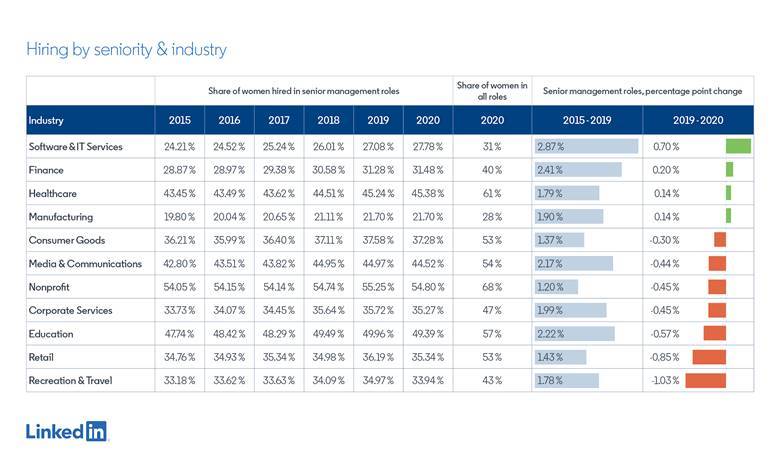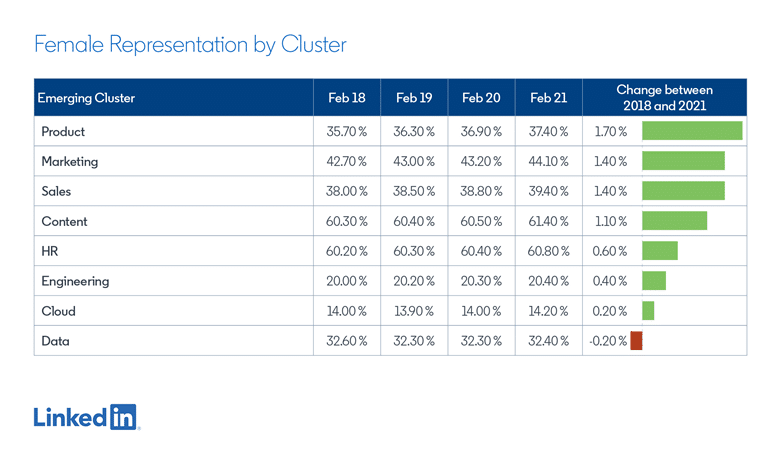- Majority of fast growing jobs miss gender parity, according to new LinkedIn data
- Gender gaps more prevalent in roles requiring disruptive tech skills
- Marked decline of women hired into leadership roles during pandemic, reversing 1-2 years of progress
- Urgent action needed from government, business and the education sector to improve female representation as economies emerge from the pandemic
The vast majority of fast-growing jobs do not have gender parity and many show a severe under-representation of women, finds new data from LinkedIn, the world’s largest professional network. LinkedIn identified 99 jobs that are consistently growing in demand across 20 economies and looked at female representation across those roles. The data – published in the World Economic Forum’s Global Gender Gap Report – suggests that gender parity problems will get worse without effective action.
Gender Gaps More Prevalent in Roles Requiring Disruptive Technical Skills.
Fast growing roles see a high influx of new talent but female representation has barely changed since 2018.* To better understand trends, fast growing jobs were clustered into eight areas: Marketing, Sales, People and Culture, Content Production, Product Development, Cloud Computing, Engineering, Data and AI.
The current share of women in Cloud Computing is 14.2%, an improvement of 0.2 percentage points since 2018; women in Data and AI roles is 32.4%, down 0.1 percentage points since February 2018. The data also shows that gender gaps were more likely in roles in Cloud Computing, Engineering, Data and AI fields that require disruptive technical skills, such as Full Stack Developers, Data Engineers and Cloud Engineers.
Sue Duke, Head of Global Public Policy, at LinkedIn, said: “Women aren’t well represented in the majority of fast-growing roles which means we are storing up even bigger gender representation problems as we emerge from the pandemic. These roles play a significant part in shaping all aspects of technology and how it is deployed in the world. We simply have to have women’s voices and perspectives represented at this foundational stage, especially as digitisation is only accelerating.
Companies and governments need to build diversity, equity and inclusion into their plans for recovery. Assessing candidates on their skills and potential, and not just their direct work experience and formal qualifications, is central to that. Skills-based hiring is key if we’re going to make our economies and societies more inclusive.”
Fall in Women Hired into Leadership Roles During Pandemic
LinkedIn data also shows a marked decline of women being hired into leadership roles since the pandemic, leading to a reversal of 1 to 2 years of progress across multiple industries. Four industries made progress and expanded the share of women hired into senior manager roles: Software and IT Services, Financial Services, Healthcare, and Manufacturing. Other industries have seen notable declines; among them, Recreation and Travel, Retail, Education, and Professional Services.




Opportunities to Address the Imbalance
As governments and companies plan their responses to the Covid-pandemic, the Global Gender Gap report recommends gender is factored into economic recovery approaches. This includes making sure business cultures and structures embrace diversity, and suggests organisations look at how to embed equity in talent sourcing and selection; and create more equitable approaches to employee experience, reward and development.
To help people and businesses move to a skills-based economy, where skills and potential have as much value as qualifications and experience, Microsoft and LinkedIn are launching a range of new tools and platforms designed to improve workforce diversity and ensure a fair recovery. Further information about these resources is available here.
Do you have an article, infographic, podcast, presentation slides, press release or a key individual from your organisation that you'd like to highlight on Marketing In Asia? Head on over to Upload Your Content for more info.



















